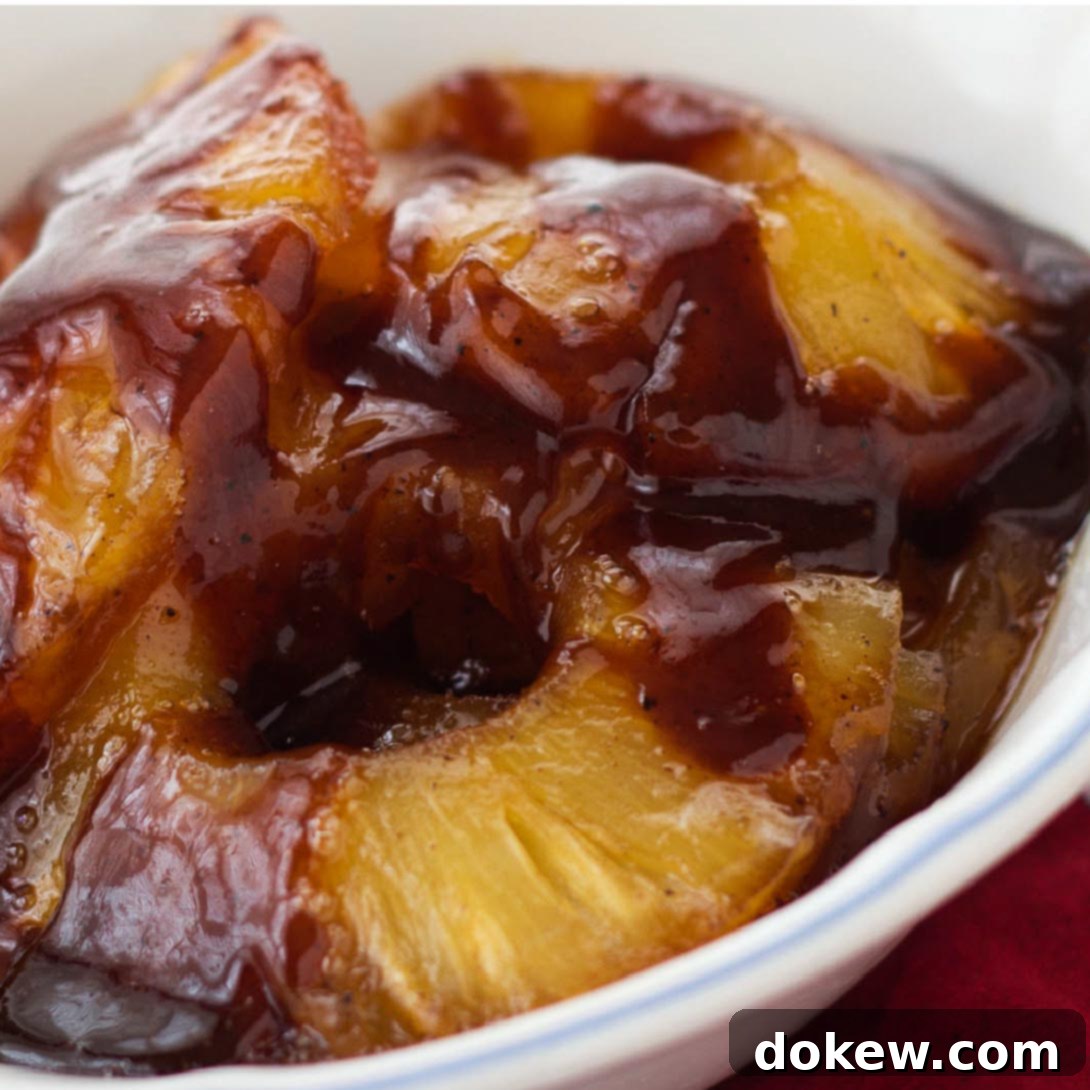Easy Caramelized Pineapple: Your Ultimate 3-Ingredient Dessert & Side Dish Guide
Unleash the tropical sweetness with this incredibly simple, yet utterly delicious, caramelized pineapple recipe. Requiring just three essential ingredients and a single pan, you can transform ordinary pineapple into a golden, buttery, and deeply flavorful treat in under 15 minutes. Whether you’re looking for a quick and impressive dessert to serve with vanilla ice cream or a vibrant, sweet side dish to elevate your holiday meals, this recipe is a true game-changer. It’s wonderfully versatile, allowing you to use either fresh, juicy pineapple or conveniently canned varieties, making it accessible year-round.
Caramelizing pineapple isn’t just about adding sweetness; it’s about deepening its natural flavors, creating a rich, almost candy-like exterior while keeping the interior tender and juicy. The process is straightforward, yielding a stunning result that tastes far more complex than its humble ingredient list suggests. Get ready to impress your family and friends with this effortless culinary delight that perfectly balances tangy and sweet notes, making it an instant crowd-pleaser for any occasion.
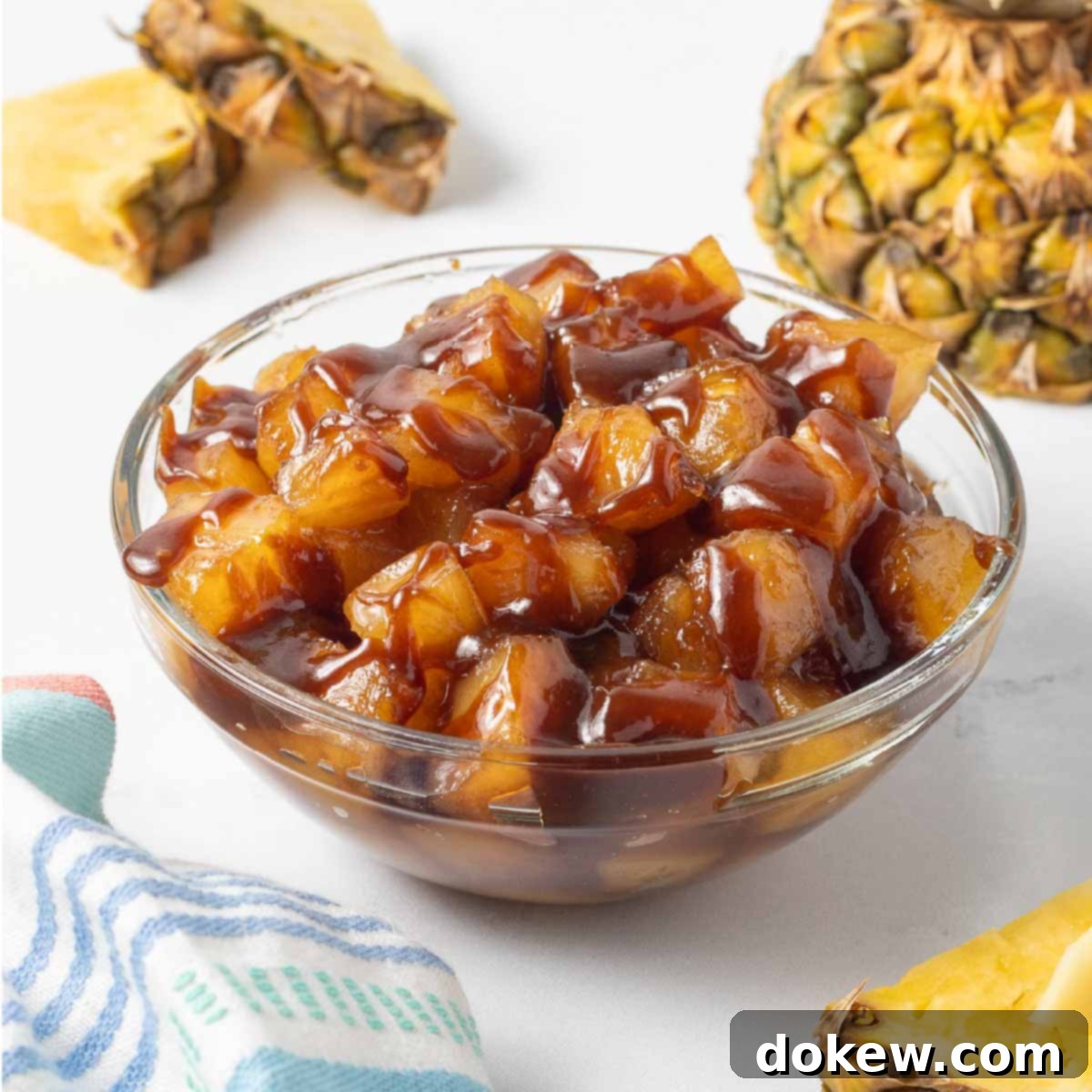
Watch the Recipe Video
Key Ingredients for Delicious Caramelized Pineapple
Crafting this irresistible caramelized pineapple requires only three simple ingredients, proving that extraordinary flavor doesn’t need a lengthy shopping list. Each component plays a crucial role in developing the perfect balance of sweetness, richness, and tropical tang.
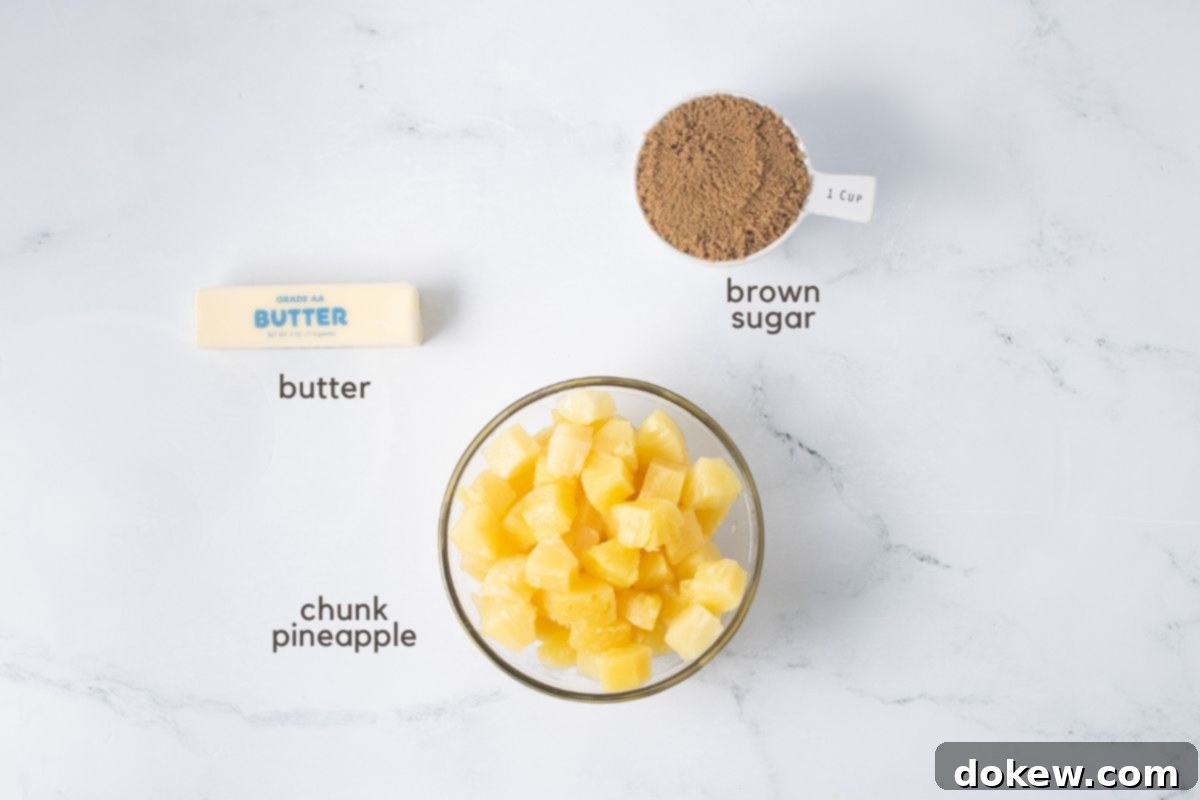
- Butter. This is non-negotiable for achieving that deep, nutty caramel flavor and a smooth, luxurious sauce. Real butter provides the necessary fat and milk solids that toast beautifully, contributing to the richness of the caramel. Margarine or butter substitutes will simply not yield the same exquisite results.
- Brown sugar. The molasses content in brown sugar is key to its distinct flavor and soft texture, which creates a much richer, more complex caramel compared to white sugar. You can use either light or dark brown sugar, with dark brown sugar offering a more intense molasses flavor for an even deeper caramel.
- Pineapple. The star of our show! You have the flexibility to use either fresh or canned pineapple, both of which work beautifully in this recipe.
- Fresh Pineapple: Opt for a ripe pineapple for the best flavor. Look for one that’s more yellow than green, with a sweet aroma at the base. Avoid overly orange pineapples, which might be past their prime. Fresh pineapple offers a brighter, tangier note and a firmer texture that holds up well to caramelization.
- Canned Pineapple: A fantastic time-saver, canned pineapple is equally delicious. Ensure you drain it thoroughly before use to avoid excess moisture, which can hinder proper caramelization. You can use rings, chunks, or even wedges. The slight syrupiness of canned pineapple often helps the caramel cling beautifully.
These three simple ingredients combine synergistically to create a dessert or side dish that’s far greater than the sum of its parts. The buttery richness, the sweet depth of brown sugar, and the vibrant tang of pineapple come together in a symphony of flavors that will delight your palate.
How to Perfectly Caramelize Pineapple on the Stovetop
Caramelization is a culinary marvel that transforms sugar into a rich, complex, and deeply flavored sauce through heating. In this incredibly easy recipe, we harness this process to create a luscious caramel from butter and brown sugar, into which we then cook the pineapple. This method infuses the pineapple with a warm, sweet glaze while allowing its natural sugars to lightly caramelize as well, resulting in a tender, golden-brown fruit with an irresistible sheen.
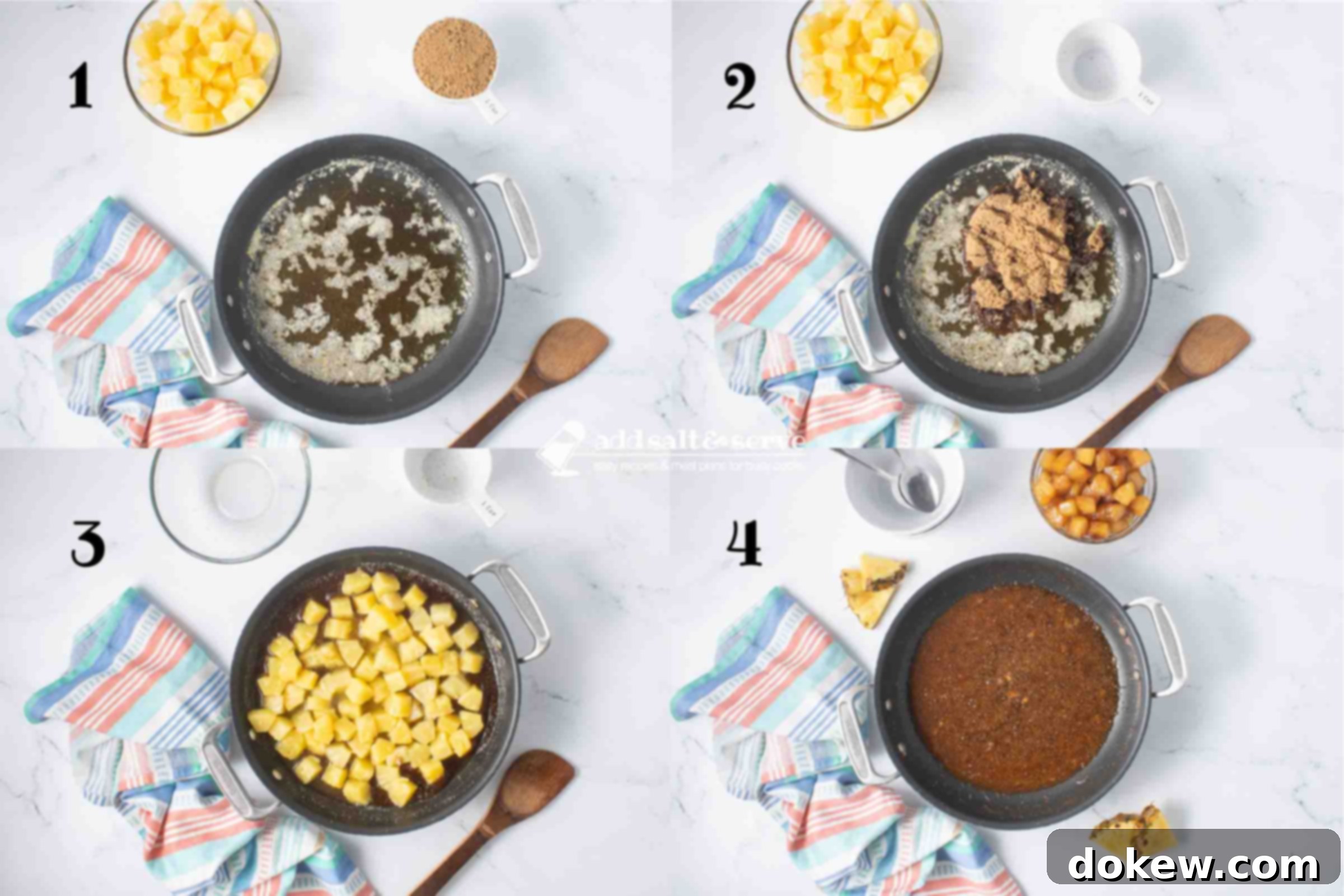
Step-by-Step Caramelization Process:
- Prepare Your Pineapple:
If you’re using canned pineapple, the most important step is to drain it thoroughly. Excess liquid will dilute your caramel sauce and prevent proper browning. For fresh pineapple, careful preparation is key:
- Peeling: Lay the pineapple on its side and slice off the top and bottom, about ½ inch of the fruit. Stand it upright and carefully slice off the outside skin in narrow strips, following the curve of the fruit. Be sure to remove all the “eyes.”
- Corinng & Slicing: If you desire rings, you’ll need a pineapple corer to remove the tough central core before slicing into even rings. For chunks or wedges, cut the pineapple in half lengthwise from top to bottom, then repeat until you have quarters. Stand each quarter on end and slice out the hard, fibrous core from the inner edge. Then, slice the remaining fruit into your desired size of chunks or wedges. Evenly sized pieces will ensure uniform cooking.
- Create the Caramel Base:
Melt the butter in a large, heavy-bottomed skillet over medium heat (1). Allow the butter to fully melt and just begin to brown slightly, which will add a lovely nutty depth to your caramel. Then, add the brown sugar to the melted butter (2). Stir continuously over medium heat. The sugar will gradually dissolve into the butter, creating a thick, syrupy mixture. Continue stirring until the sugar is completely dissolved and the mixture is smooth and bubbling gently. This typically takes about 2-3 minutes. Avoid high heat, as it can cause the caramel to burn or become grainy.
- Cook the Pineapple:
Once your caramel base is ready, carefully add the prepared pineapple pieces to the skillet (3). Arrange them in a single layer if possible, ensuring each piece gets good contact with the caramel. Cook the pineapple, turning occasionally, until it develops a beautiful golden-brown color and is tender-crisp.
- For Rings: Cook for approximately 3-4 minutes per side.
- For Chunks or Wedges: Stir frequently and cook for about 6-8 minutes total, ensuring all sides are nicely coated and caramelized.
The goal is to get a lovely caramelized exterior without letting the pineapple become mushy.
- Reduce the Caramel Sauce:
Once the pineapple is caramelized to your liking, remove the pieces from the skillet and transfer them to a serving bowl, leaving the remaining caramel sauce in the pan (4). Now, increase the heat to medium-high and continue cooking the sauce, stirring constantly, for about 5 minutes. This step reduces the sauce, concentrating its flavors and thickening it to a perfect pourable consistency – aim to reduce it by about a third. It will become even richer and glossier.
- Serve and Enjoy:
Pour the warm, reduced caramel syrup generously over the caramelized pineapple. Serve immediately. This delightful dish makes a delicious topping for vanilla ice cream, a decadent addition to cheesecake, or a superb standalone dessert. It’s also fantastic as a sweet side dish alongside roasted pork or ham, adding a touch of tropical elegance to any meal.
Pro Tips for the Best Caramelized Pineapple:
- Don’t Rush the Caramel: Patience is key when dissolving the brown sugar. Keep the heat at medium and stir consistently to prevent burning or crystallization.
- Single Layer Cooking: If your skillet isn’t large enough to accommodate all pineapple in a single layer, cook it in batches. Overcrowding the pan can steam the pineapple instead of caramelizing it, leading to less browning and a watery sauce.
- Adjust Sweetness: Taste your caramel sauce before adding the pineapple. If you prefer it less sweet, a tiny pinch of salt can help balance the flavors.
- Freshness Factor: Using fresh, ripe pineapple will yield a more vibrant and tangy result, contrasting beautifully with the rich caramel.
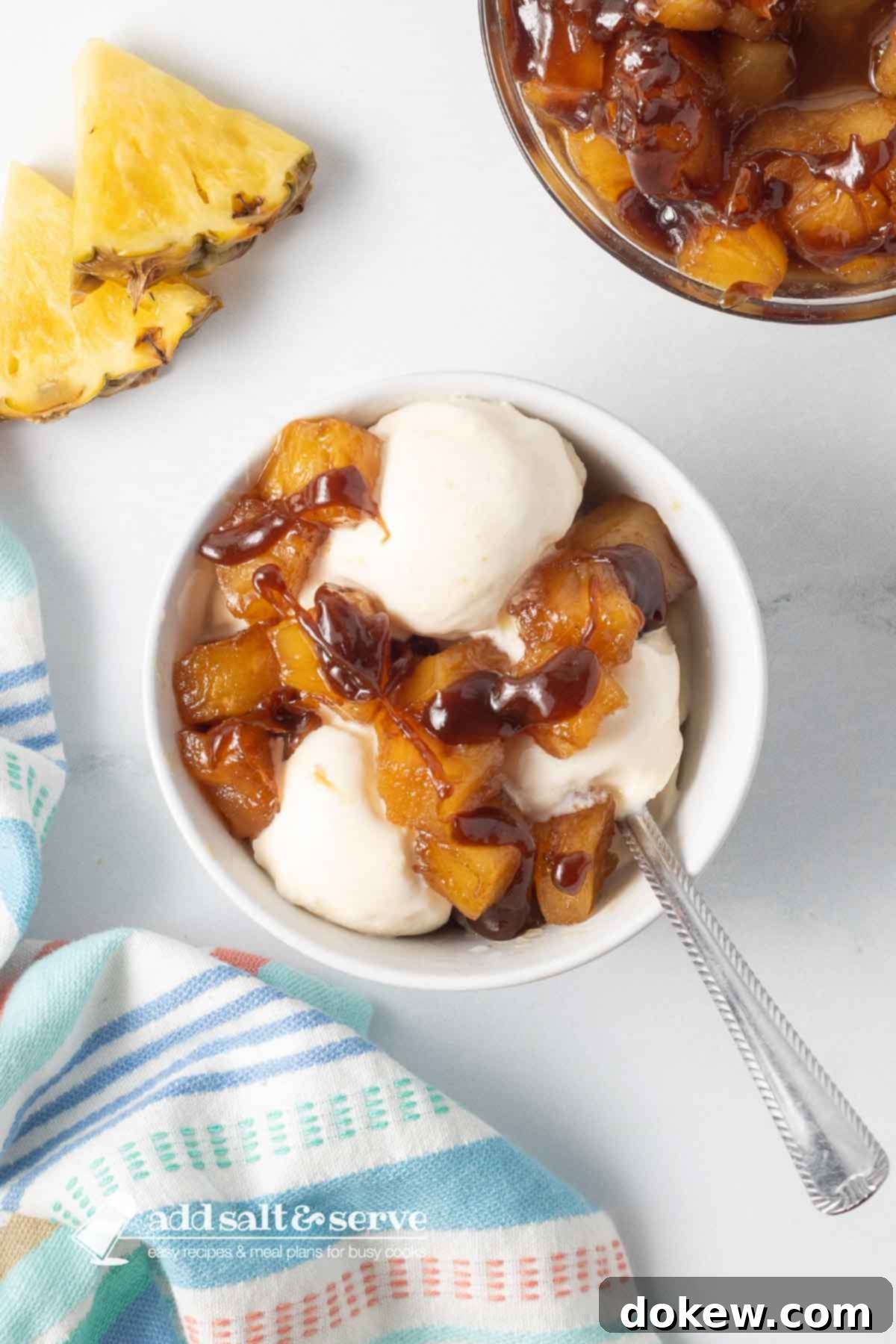
Frequently Asked Questions About Caramelized Pineapple
Got questions about making the perfect caramelized pineapple? We’ve got answers! This section addresses common inquiries to ensure your culinary success.
Can I use fresh pineapple for this recipe?
Absolutely, fresh pineapple is an excellent choice for this recipe and often provides a more vibrant, tangy flavor. When selecting a fresh pineapple, look for one that is more yellow than green on the exterior, feels heavy for its size, and emits a sweet, tropical aroma from its base. Gently squeeze it; it should yield slightly. Avoid pineapples that are excessively orange, as this can indicate they are overripe. Once you’ve chosen your ripe pineapple, follow the instructions for peeling, coring, and slicing it into rings, chunks, or wedges as indicated in the “How to Caramelize Pineapple” section above. Fresh pineapple holds its shape beautifully and its natural sugars contribute wonderfully to the caramelization process.
What’s the best way to cut a fresh pineapple?
Cutting a fresh pineapple might seem daunting, but it’s quite simple with a sharp knife and a stable cutting board. First, lay the pineapple on its side and carefully cut off the top and bottom ends, including about a half-inch of the fruit. This creates flat surfaces. Next, stand the pineapple upright on one of its flat ends. Starting from the top, slice downwards, following the natural curve of the fruit, to remove the tough outer skin. Go around the entire pineapple until all the spiky skin and “eyes” are removed. For cutting into rings, use a pineapple corer to remove the fibrous core from the center of the cylinder, then slice the remaining fruit into even rings. For chunks or wedges, cut the peeled pineapple in half lengthwise, then halve each half again to create quarters. Stand each quarter on its end and slice away the hard, pale core from the inner edge. Finally, cut the remaining fruit into desired chunks or wedges. Uniformity in size is helpful for even caramelization.
If I use fresh pineapple, can I grill it first?
Yes, grilling fresh pineapple before adding the caramel sauce is an outstanding option that adds another layer of complex flavor. The high heat of the grill intensifies the pineapple’s sweetness and imparts a smoky, slightly charred taste that pairs beautifully with the rich caramel. To do this, simply slice your fresh pineapple into rings or substantial wedges. Brush them lightly with a neutral oil (like canola or grapeseed) to prevent sticking, then grill over medium-high heat for 2-4 minutes per side, or until they develop nice grill marks and soften slightly. Once grilled, transfer them to a serving platter and generously drizzle the prepared caramel sauce over the top. This method is particularly recommended for summer barbecues or when you want an extra depth of flavor.
Can I use canned pineapple tidbits or crushed pineapple?
While technically possible, this recipe is designed for pineapple slices, chunks, or substantial wedges, as these cuts hold their shape well and develop a satisfying caramelized exterior. Smaller pieces like tidbits or crushed pineapple tend to break down too much during the cooking process, becoming more integrated into the caramel sauce rather than maintaining distinct fruit pieces. If you’re looking for a pineapple topping for something like pancakes or yogurt, tidbits might work, but for the intended texture and presentation of caramelized pineapple as a dessert or side, we highly recommend sticking to larger cuts. The goal is to have distinct, beautifully browned pieces of fruit coated in luscious caramel.
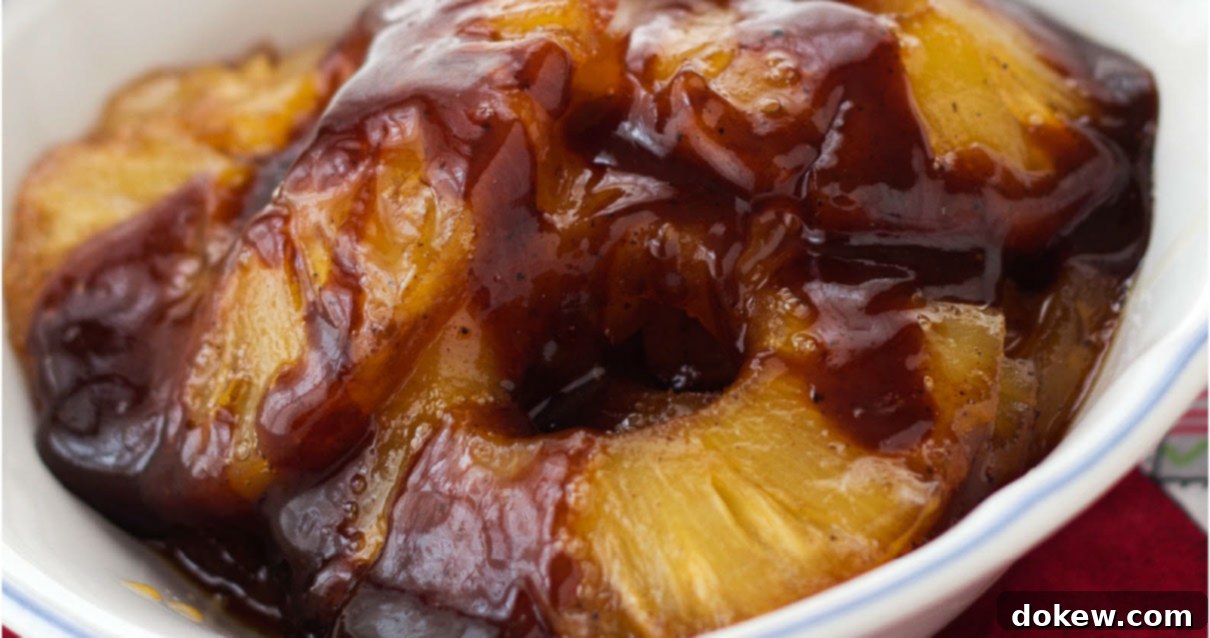
How do I store and reheat caramelized pineapple?
Caramelized pineapple is best enjoyed fresh and warm, but leftovers can be stored. Place any remaining caramelized pineapple and its sauce in an airtight container and refrigerate for up to 3-4 days. To reheat, you have a couple of options:
- Microwave: For a quick reheat, place the pineapple in a microwave-safe dish and heat in 30-second intervals, stirring occasionally, until warmed through. Be careful not to overheat, as the caramel can become too soft or separate.
- Stovetop: For the best results, especially if you want to restore some of that fresh-cooked texture, reheat the pineapple in a skillet over low to medium heat, stirring gently until it’s warmed and the sauce is fluid again. This method helps maintain the integrity of the caramel.
While the texture might soften slightly upon reheating, the flavors will still be wonderfully sweet and rich.
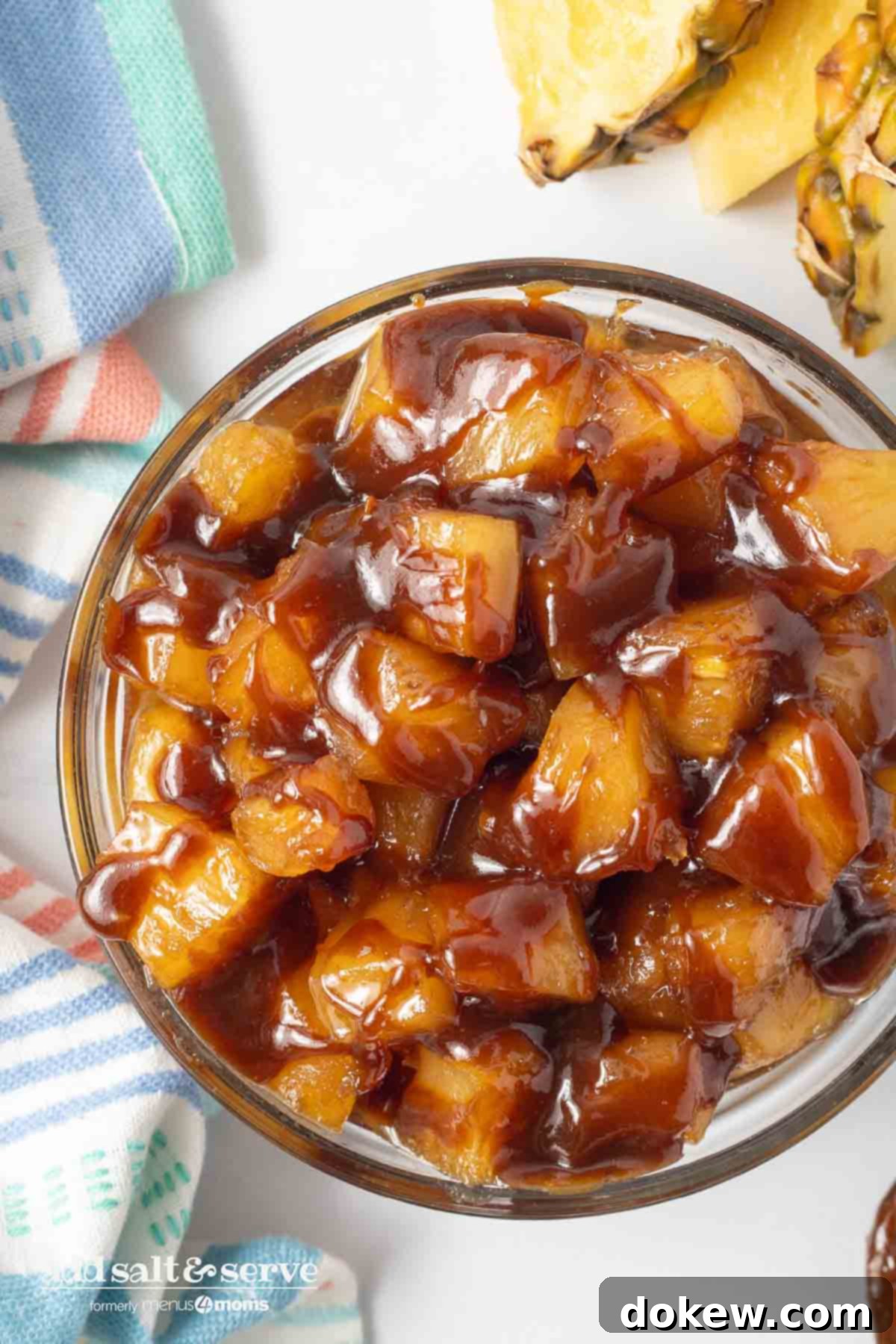
Recipe: Easy 3-Ingredient Caramelized Pineapple
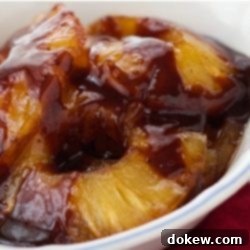
Easy Caramelized Pineapple (3 Ingredients)
Mary Ann
Go to Collections
Add to Shopping List
Go to Shopping List
15 minutes
15 minutes
Dessert, Side Dish
American, Tropical
10
232
Ingredients
-
40
ounces
canned pineapple rings or chunks,
well-drained, or 1 fresh pineapple (peeled, cored, and sliced) -
8
tablespoons
unsalted butter (1 stick) -
1
cup
packed brown sugar (light or dark)
Prevent your screen from going dark
Instructions
-
If using fresh pineapple, peel, core, and slice it into your desired chunks or rings. If using canned pineapple rings or chunks, ensure they are thoroughly drained of all liquid.
-
Melt 8 tablespoons butter in a large, heavy-bottomed skillet over medium heat. Allow the butter to fully melt and start to slightly brown, enhancing its nutty flavor. Add 1 cup brown sugar and stir constantly until the sugar completely dissolves and the mixture thickens into a smooth, bubbling syrup.
-
Add the prepared pineapple to the skillet, arranging it in a single layer if possible. Cook the pineapple until it develops a beautiful golden-brown color and is tender-crisp. This takes about 3-4 minutes per side for rings, or approximately 6-8 minutes total for chunks, stirring occasionally to ensure even caramelization.
-
Once caramelized, carefully remove the pineapple pieces from the skillet and transfer them to a serving bowl, leaving the remaining caramel sauce in the pan.
-
Increase the heat to medium-high and reduce the caramel sauce by about a third. Stir constantly for around 5 minutes, allowing the sauce to thicken and its flavors to intensify.
-
Pour the warm, reduced caramel syrup generously over the pineapple. Serve immediately, either on its own as a delightful dessert or alongside a scoop of vanilla ice cream.
Notes
Nutrition per serving
Calories:
232
cal
Carbohydrates:
39
g
Protein:
1
g
Fat:
9
g
Sodium:
87
mg
Fiber:
1
g
Sugar:
38
g
Net Carbohydrates:
38
g
Share
Pin
